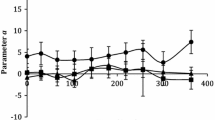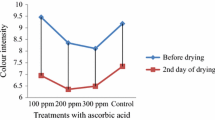Abstract
This study evaluated the use of sodium metabisulphite (SMB) and ascorbic acid (AA) to control browning in ready-to-eat processed potatoes during 8 months of storage. The experiment was carried out using the production line of a commercial potato processing business located in the state of Paraná, Brazil. The following treatments were tested in the immersion process of the potatoes: T1 (control, without additives), T2 (0.5% m/v SMB) and T3 (0.25% m/v SMB + 0.25% m/v AA). For quality control of the products, total soluble solids content, pH, total titratable acidity and colour were evaluated. Statistical differences between chemical treatments (T1, T2 and T3) and between storage periods (1 day, 1, 2, 4, 6, 8 months) were evaluated in completely randomized design. The quality of ready-to-eat processed potatoes (sterilized and vacuum packed) treated with SMB and AA was maintained for at least 4 months of storage. After this period, there was significant browning, but there were no changes in pH, titratable acidity and total soluble solids. At the end of storage (6 and 8 months), the treatment T3 (0.25% m/v SMB + 0.25% m/v AA) gave better results for colour.
Similar content being viewed by others
References
Aerts O, Duchateau N, Lambert J, Bechtold T (2014) Sodium metabisulfite in blue jeans: an unexpected cause of textile contact dermatitis. Contact Dermatitis 70:190–192
Arroyo-López FN, Bautista-Gallego J, Durán-Quintana MC, Garrido-Fernández A (2008) Effects of ascorbic acid, sodium metabisulfite and sodium chloride on freshness retention and microbial growth during the storage of Manzanilla-Aloreña cracked table olives. LWT-Food Sci Technol 41:551–560
AOAC (2005) Official methods of analysis of AOAC international. Washington
Beckles DM (2012) Factors affecting the postharvest soluble solids and sugar content of tomato (Solanum lycopersicum L.) fruit. Postharvest Biol Technol 63:129–140
Bharate SS, Bharate SB (2014) Non-enzymatic browning in citrus juice: chemical markers, their detection and ways to improve product quality. J Food Sci Technol 51:2271–2288
Buckley RR, Giorgianni EJ (2014) Cielab for color image encoding (cielab, 8-bit; domain and range, uses). In: Luo R (ed) Encyclopedia of color science and technology. Springer, Berlin, pp 1–9
Capuano E, Fogliano V (2011) Acrylamide and 5-hydroxymethylfurfural (HMF): a review on metabolism, toxicity, occurrence in food and mitigation strategies. LWT-Food Sci Technol 44:793–810
Ceroli P, Procaccini LMG, Corbino G, Monti MC, Huarte M (2018) Evaluation of food conservation technologies for potato cubes. Potato Res 61:219–229
FAO (2018) World food and agriculture: statistical pocketbook. Rome
Furrer AN, Chegeni M, Ferruzzi MG (2018) Impact of potato processing on nutrients, phytochemicals, and human health. Crit Rev Food Sci Nutr 58:146–168
García-Gavín J, Parente J, Goossens A (2012) Allergic contact dermatitis caused by sodium metabisulfite: a challenging allergen. A case series and literature review. Contact Dermatitis 67:260–269
Goyeneche R, Agüero MV, Roura S, Scala K (2014) Application of citric acid and mild heat shock to minimally processed sliced radish: color evaluation. Postharvest Biol Technol 93:106–113
Green LF (1976) Sulphur dioxide and food preservation-a review. Food Chem 1:103–124
Guha-Niyogi B, Sabroe R, Holden C (2018) An unusual case of a systemic delayed hypersensitivity reaction to sodium metabisulfite. Contact Dermatitis 79:246–247
Liang YS, Chen NL, Ke LS (2012) Influence of dipping in sodium metabisulfite on pericarp browning of litchi cv. Yu Her Pau (Feizixiao). Postharvest Biol Technol 68:72–77
Lovatto MT, Bisognin DA, Treptow RO, Storck L, Gnocato FS, Morin Junior G (2012) Processamento mínimo de tubérculos de batata de baixo valor comercial. Hortic Bras 30:258–265
Lück E, Jager M (1997) Sulfur Dioxide. In: Lück E, Jager M (eds) Antimicrobial food additives – characteristics, uses, effects. Springer-Verlag, Berlin, pp 102–113
Machado RM, Toledo MC, Vicente E (2006) Sulfitos em alimentos. Braz J Food Technol 9:265–275
Matos IMDCM, Cavalcante AAM, Dantas AF, Pereira DLA, Rocha FCC, de Oliveira FM, Da Silva J (2011) Environmental mutagenicity and toxicity caused by sodium metabisulfite in sea shrimp harvesting in Piauí, Brazil. Chemosphere 82:1056–1061
Ma Y, Wang Q, Hong G, Cantwell M (2010) Reassessment of treatments to retard browning of fresh-cut russet potato with emphasis on controlled atmospheres and low concentrations of bisulphite. Int J Food Sci Tech 45:1486–1494
Melo Filho AB, Vasconcelos MAS (2011) Química de alimentos. UFRPE, Recife, 78 p
Murniece I, Karklina D, Galoburda R, Santare D, Skrabule I, Costa HS (2011) Nutritional composition of freshly harvested and stored Latvian potato (Solanum tuberosum L.) varieties depending on traditional cooking methods. J Food Compost Anal 24:699–710
Murata M, Sugiura M, Sonokawa Y, Shimamura T, Homma S (2002) Properties of chlorogenic acid quinone: relationship between browning and the formation of hydrogen peroxide from a quinone solution. Biosci Biotechnol Biochem 66:2525–2530
Nascimento RF, Canteri MHG (2019) Use of sodium metabisulfite and ascorbic acid as anti-browning agents in processed potatoes. Brit Food J 122:380–389
Ogunjobi AA, Adebayo-Tayo BC, Ogunshe AA (2005) Microbiological, proximate analysis and sensory evaluation of processed Irish potato fermented in brine solution. Afr J Biotechnol 4:1409–1412
Pineli LLO, Almeida GC, Onuki ACA, Nascimento ABG (2005) Caracterização química e física de batatas' Ágata' minimamente processadas, embaladas sob diferentes atmosferas modificadas ativas. Pesq Agropec Bras 40:1035–1041
Revoredo-Giha C (2014) Hitting the jackpot and the health agenda: the case of processed potato products. Procedia Econ 14:525–533
Rocha AM, Coulon EC, Morais AM (2003) Effects of vacuum packaging on the physical quality of minimally processed potatoes. Food Serv Tech 3:81–88
Schulbach KF, Johnson JV, Simonne AH, Kim JM, Jeong Y, Yagiz Y, Marshall MR (2013) Polyphenol oxidase inhibitor from blue mussel (Mytilus edulis) extract. J Food Sci 78:C425–C431
Serpen A, Gökmen V (2009) Evaluation of the Maillard reaction in potato crisps by acrylamide, antioxidant capacity and color. J Food Compos Anal 22:589–595
Soares JM, Fonseca GG (2008) Effect of L-ascorbic acid and sodium metabisulfite in the inhibition of the enzymatic browning of minimally processed apple. Int J Agric Res 3:196–201
Taylor SL, Higley NA, Bush RK (1986) Sulfites in foods: uses, analytical methods, residues, fate, exposure assessment, metabolism, toxicity, and hypersensitivity. In: Mrak EM, Schweigert BS (eds) Chichester CO. Academic Press, Advances in food research, pp 1–76
Toivonen PM, Brummell DA (2008) Biochemical bases of appearance and texture changes in fresh-cut fruit and vegetables. Postharvest Biol Technol 48:1–14
Tsouvaltzis P, Brecht JK (2017) Inhibition of enzymatic browning of fresh-cut potato by immersion in citric acid is not solely due to pH reduction of the solution. J Food Process Pres 41:e12829
Tyl C, Sadler GD (2017) pH and titratable acidity. In: Nielsen SS (ed) Food analysis. Springer, Cham, pp 389–406
Uluata S, McClements DJ, Decker EA (2015) How the multiple antioxidant properties of ascorbic acid affect lipid oxidation in oil-in-water emulsions. J Agr Food Chem 63:1819–1824
Virmond EP, Kawakami J, Voncik KS, Córdova KRV, Slompo PJH (2014) Características físico-químicas de cultivares de batata sob cultivo orgânico. Ambiência 10:31–42
Vitaliti G, Guglielmo F, Giunta L, Pavone P, Falsaperla R (2015) Sodium metabisulphite allergy with multiple food and drug hypersensitivities in a five-year-old child: a case report and literature review. Allergol Immunopathol 43:106–108
Wang-Pruski G, Nowak J (2004) Potato after-cooking darkening. Am J Potato Res 81:7–16
Yuan J, Bizimungu B, Leblanc D, Lague M (2019) Effects of field selection parameters and specific gravity on culinary evaluation traits in a potato breeding programme. Potato Res 62:316–377
Acknowledgements
This study was financed in part by the Coordenação de Aperfeiçoamento de Pessoal de Nível Superior–Brasil (CAPES)–Finance Code 001.
Author information
Authors and Affiliations
Corresponding author
Additional information
Publisher’s Note
Springer Nature remains neutral with regard to jurisdictional claims in published maps and institutional affiliations.
Rights and permissions
About this article
Cite this article
do Nascimento, R.F., Canteri, M.H.G., Rodrigues, S.Á. et al. Use of Sodium Metabisulphite and Ascorbic Acid to Control Browning in Ready-to-Eat Processed Potatoes during Prolonged Storage. Potato Res. 63, 615–625 (2020). https://doi.org/10.1007/s11540-020-09461-1
Received:
Accepted:
Published:
Issue Date:
DOI: https://doi.org/10.1007/s11540-020-09461-1




